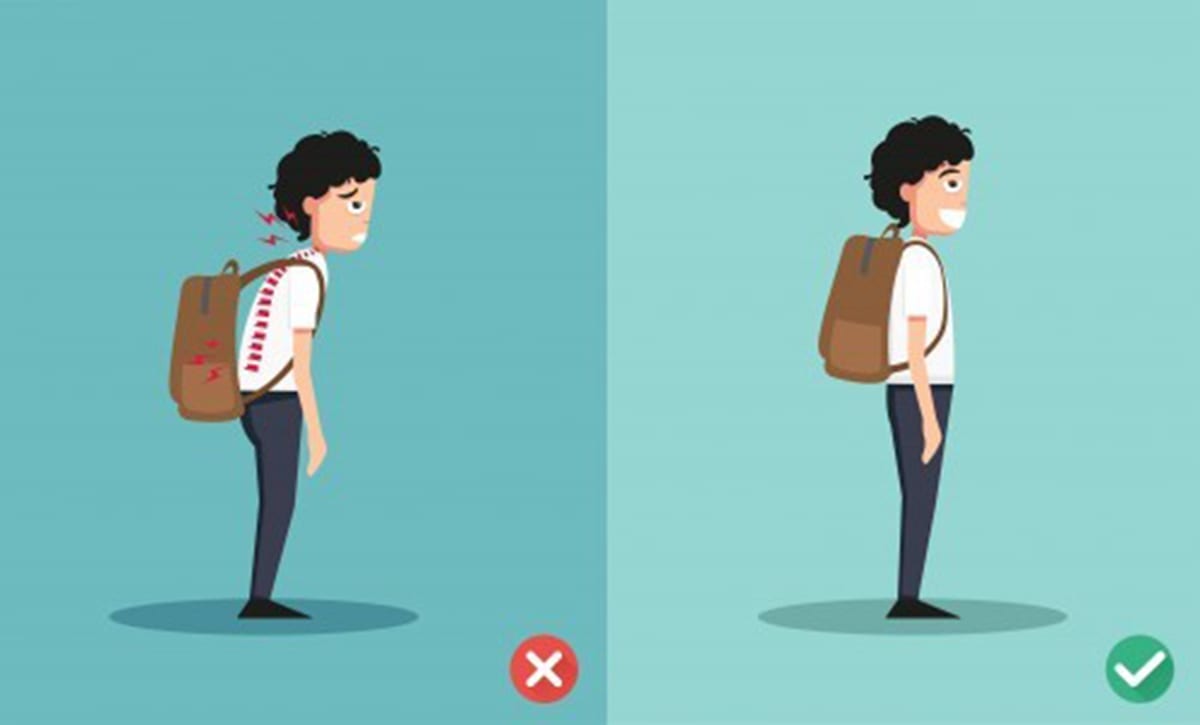
Back to school season is upon us, which means backpacks are being pulled out from the closet and dusted off. But did you know that your backpack can have an impact on your health? Trust us, back to school doesn’t have the mean back pain!
Backpacks that are too heavy, poor carrying habits and subsequent compensations may cause anything from minor neck, shoulder, and low back strain, to stress fractures and bulging disks.
So, whether you are sending your child to their very first day of Kindergarten, or getting ready for your last first day of school, here a few things to remember when packing your bag.
Weight; how much is too much?
Studies have shown that appropriate backpack weight recommendations range between 10-15% of an individual’s body weight (BW).
For example, a 40lb child should not have a backpack exceeding 6lb, while a 135lb adult should not have a backpack exceeding 20lb. However, it has been found that up to 38% of children carry backpacks that exceed 20% of their BW.
It’s important to note that the higher the weight of the bag, the higher the compression force subjected to the spine.
For example, a bag that is 15% of a person’s BW creates a 26% compression force to the back, while a bag that is 40% of a person’s BW can add up to a 64% compression force to the back.
Loads as low as 10% of BW influence the spine’s curvature and body mechanics to support the load.[5][6]
Low back and shoulders

To compensate and support this load on our back, we oftentimes lean forward in what is described as “forward trunk inclination” (Figure 1).
- Younger children may also adopt an arched back posture to support this weight.
- Carrying a heavy pack changes the way kids walk and puts them at risk of falling, particularly in stairs.[1]
- Those who wear backpacks over only one shoulder may start leaning to one side to counter the unbalanced weight.[1][7]
Neither of these positions are biomechanically ideal.
They can cause unnatural compression forces and create musculoskeletal pain in children and adults alike.[1][6]
Long term, all of these factors can increase trunk stiffness, bad posture, affect the coordination in the pelvis and trunk, and add excessive mechanical loading in the low back which may be the cause of low back pain.[1][4]
Furthermore, when holding a backpack, the area of highest discomfort is often found to be the shoulders. Studies have shown that, when wearing a backpack, the straps significantly deform the soft tissue of the shoulder and can actually change the way blood flow and oxygen reach the skin and muscles.[2] This is especially true if the straps are narrow and unpadded.
Even in adults, carrying a backpack for 10-45 min can create discomfort and changes in upper extremity sensation.[2] Too-heavy loads may have greater impacts such a Thoracic Outlet Syndrome (TOS) where a subset of nervous and vascular structures in the shoulders are compressed.
This can cause feelings of numbness, pain, tingling or even electrical shock sensations down your arms.[3][7]
Helpful tips
- Avoid carrying backpacks on a single shoulder, always put both straps on.[1][7]
- Make sure shoulder straps are wide, comfortable, well-padded, and can be adjusted.[1][7]
- The bag should rest in the middle of the back with heavier items closer to the back.[1]
- Use the waist and/or chest straps. They can help evenly distribute the weight and offer better balance.[1][7]
- Treat a backpack as you would any heavy load (remember, it may not seem heavy to you but it is for your child!). Teach them to bend at the knees, grab the bag with both hands and lift it up while straightening the knees to place the backpack on their shoulders.[7]
- Bags with compartments help evenly distribute weight.[1][7]
- Lighten the load! Don’t leave in unnecessary things, only pack what is needed for that day, and carry your lunch box in your hands instead.[1][7]
- Postural exercises to avoid bad posture.[7]
Let us Help You!
If you have any questions or are worried you may have hurt yourself because of your heavy bag, contact us to book an appointment with one of our physiotherapists. We are your physiotherapy clinic in Orléans, Ottawa.
Happy backpacking!
- Dowshen, S. (2016). Backpack Safety. https://kidshealth.org/en/parents/backpack.html
- Hadid, A., Gozes, G., Atoon, A., Gefen, A., & Epstein, Y. (2018). Effects of an improved biomechanical backpack strap design on load transfer to the shoulder soft tissues. Journal of biomechanics, 76, 45-52.
- Jones, M. R., Prabhakar, A., Viswanath, O., Urits, I., Green, J. B., Kendrick, J. B., … & Kaye, A. D. (2019). Thoracic Outlet Syndrome: A Comprehensive Review of Pathophysiology, Diagnosis, and Treatment. Pain and therapy, 8(1), 5-18.
- Li, S. S., & Chow, D. H. (2018). Effects of backpack load on critical changes of trunk muscle activation and lumbar spine loading during walking. Ergonomics, 61(4), 553-565.
- Orantes-Gonzalez, E., Heredia-Jimenez, J., & Beneck, G. J. (2017). Children require less gait kinematic adaptations to pull a trolley than to carry a backpack. Gait & posture, 52, 189-193.
- Shojaei, I., Suri, C., & Bazrgari, B. (2018). The effects of backpack type on lumbo-pelvic coordination during trunk bending and return tasks. Ergonomics, 61(10), 1355-1363.
- Woulfe, M. (2018).Backpack Buying 101: How to avoid ‘backpack back’ https://www.uchicagomedicine.org/forefront/orthopaedics-articles/2018/september/backpack-buying-101

